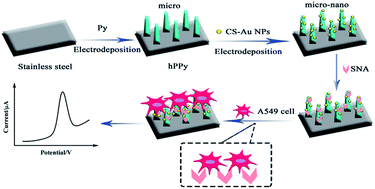当前位置:
X-MOL 学术
›
Anal. Methods
›
论文详情
Our official English website, www.x-mol.net, welcomes your
feedback! (Note: you will need to create a separate account there.)
Evaluation of sialic acid based on electrochemical cytosensor with 3D micro/nanostructured sensing interface
Analytical Methods ( IF 2.7 ) Pub Date : 2017-10-27 00:00:00 , DOI: 10.1039/c7ay02185b Shangshang Ma 1, 2, 3, 4, 5 , Sisheng Hu 4, 6, 7, 8, 9 , Qi Wang 1, 2, 3, 4, 5 , Yuhong Liu 1, 2, 3, 4, 5 , Guangyao Zhao 1, 2, 3, 4, 5 , Qicheng Zhang 1, 2, 3, 4, 5 , Chun Mao 1, 2, 3, 4, 5 , Bo Zhao 1, 2, 3, 4, 5
Analytical Methods ( IF 2.7 ) Pub Date : 2017-10-27 00:00:00 , DOI: 10.1039/c7ay02185b Shangshang Ma 1, 2, 3, 4, 5 , Sisheng Hu 4, 6, 7, 8, 9 , Qi Wang 1, 2, 3, 4, 5 , Yuhong Liu 1, 2, 3, 4, 5 , Guangyao Zhao 1, 2, 3, 4, 5 , Qicheng Zhang 1, 2, 3, 4, 5 , Chun Mao 1, 2, 3, 4, 5 , Bo Zhao 1, 2, 3, 4, 5
Affiliation

|
Sialic acid (SA), a glycoprotein associated with many pernicious diseases, has been applied to quantify cancer cells. In this paper, a novel electrochemical cytosensor with three-dimensional (3D) micro/nanostructured sensing interface, which can provide a better platform for cell adhesion, was utilized to detect the expression of SA from the cell surface. The hollow horn-like PPy (hPPy) film and chitosan–Au nanoparticles (CS–Au NPs) were electrodeposited on stainless steel and then, combined with a targeting lectin molecule of Sambucus nigra agglutinin (SNA), for sensing A549 human lung cancer cells based on the molecular recognition between SNA and SA. The morphologies, wettability and cytotoxicity of CS–Au/hPPy were investigated by scanning electron microscope (SEM), energy dispersive spectrum (EDS), water contact angle test and MTT (3-[4,5-dimethylthiazol-2-yl]-2,5 diphenyl tetrazolium bromide) assays. Furthermore, the electrochemical performances of this cytosensor with a 3D micro/nanostructured CS–Au/hPPy sensing interface were investigated. Under optimal conditions, the proposed cytosensor exhibited a good linear relationship, wide linear range of the cell concentration from 10 to 1.0 × 107 cells per mL and a detection limit as low as 2 cells per mL (S/N = 3). Moreover, the cytosensor also had good stability and specificity to analyze the over-expressed SA on living cells, implying that the new sensing interface we proposed may have a huge potential application in the study of tumor cells and greatly promote the cancer diagnosis and treatment in early stages.
中文翻译:

基于带有3D微/纳米结构传感界面的电化学细胞传感器评估唾液酸
唾液酸(SA)是一种与许多恶性疾病有关的糖蛋白,已被用于量化癌细胞。在本文中,利用具有三维(3D)微米/纳米结构传感界面的新型电化学细胞传感器,可以为细胞粘附提供更好的平台,以检测细胞表面SA的表达。将空心的角状PPy(hPPy)膜和壳聚糖-Au纳米颗粒(CS-Au NPs)电沉积在不锈钢上,然后与黑接骨木的靶向凝集素分子结合凝集素(SNA),用于基于SNA和SA之间的分子识别来感知A549人肺癌细胞。通过扫描电子显微镜(SEM),能量色散谱(EDS),水接触角测试和MTT(3- [4,5-二甲基噻唑-2-基]- 2,5二苯基溴化四唑)测定。此外,还研究了这种具有3D微米/纳米结构CS–Au / hPPy传感界面的细胞传感器的电化学性能。在最佳条件下,拟议的细胞传感器表现出良好的线性关系,细胞浓度的线性范围宽广,从10到1.0×10 7每毫升细胞数,检测限低至每毫升2细胞(S / N = 3)。此外,该细胞传感器还具有良好的稳定性和特异性,可以分析活细胞上过表达的SA,这表明我们提出的新的传感界面可能在肿瘤细胞的研究中具有巨大的潜在应用前景,并极大地促进了癌症的诊断和治疗。早期阶段。
更新日期:2017-11-09
中文翻译:

基于带有3D微/纳米结构传感界面的电化学细胞传感器评估唾液酸
唾液酸(SA)是一种与许多恶性疾病有关的糖蛋白,已被用于量化癌细胞。在本文中,利用具有三维(3D)微米/纳米结构传感界面的新型电化学细胞传感器,可以为细胞粘附提供更好的平台,以检测细胞表面SA的表达。将空心的角状PPy(hPPy)膜和壳聚糖-Au纳米颗粒(CS-Au NPs)电沉积在不锈钢上,然后与黑接骨木的靶向凝集素分子结合凝集素(SNA),用于基于SNA和SA之间的分子识别来感知A549人肺癌细胞。通过扫描电子显微镜(SEM),能量色散谱(EDS),水接触角测试和MTT(3- [4,5-二甲基噻唑-2-基]- 2,5二苯基溴化四唑)测定。此外,还研究了这种具有3D微米/纳米结构CS–Au / hPPy传感界面的细胞传感器的电化学性能。在最佳条件下,拟议的细胞传感器表现出良好的线性关系,细胞浓度的线性范围宽广,从10到1.0×10 7每毫升细胞数,检测限低至每毫升2细胞(S / N = 3)。此外,该细胞传感器还具有良好的稳定性和特异性,可以分析活细胞上过表达的SA,这表明我们提出的新的传感界面可能在肿瘤细胞的研究中具有巨大的潜在应用前景,并极大地促进了癌症的诊断和治疗。早期阶段。











































 京公网安备 11010802027423号
京公网安备 11010802027423号